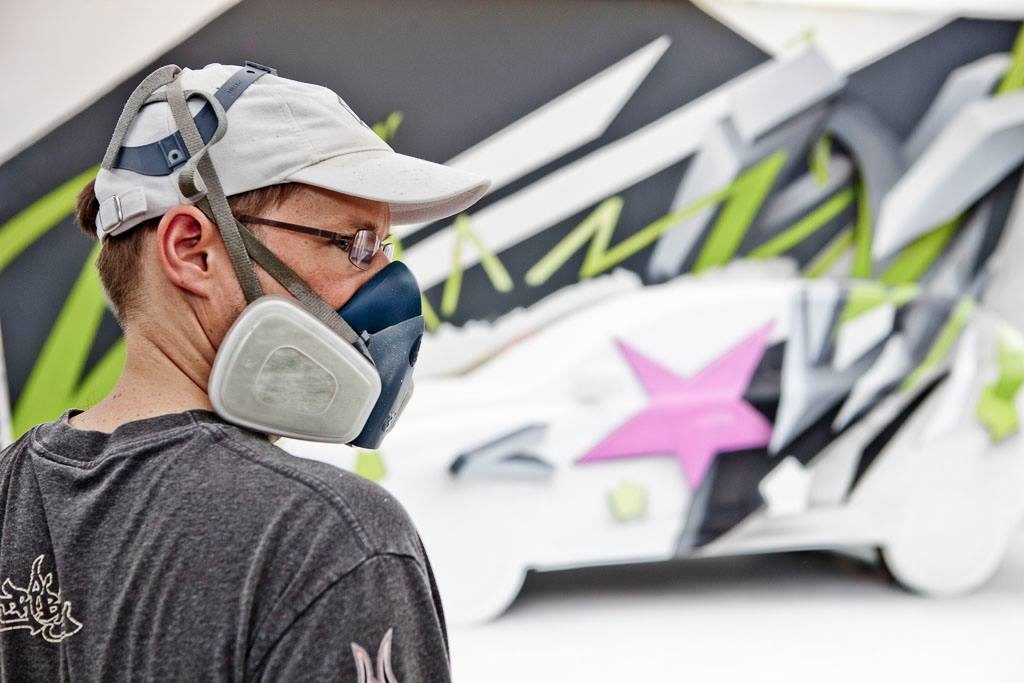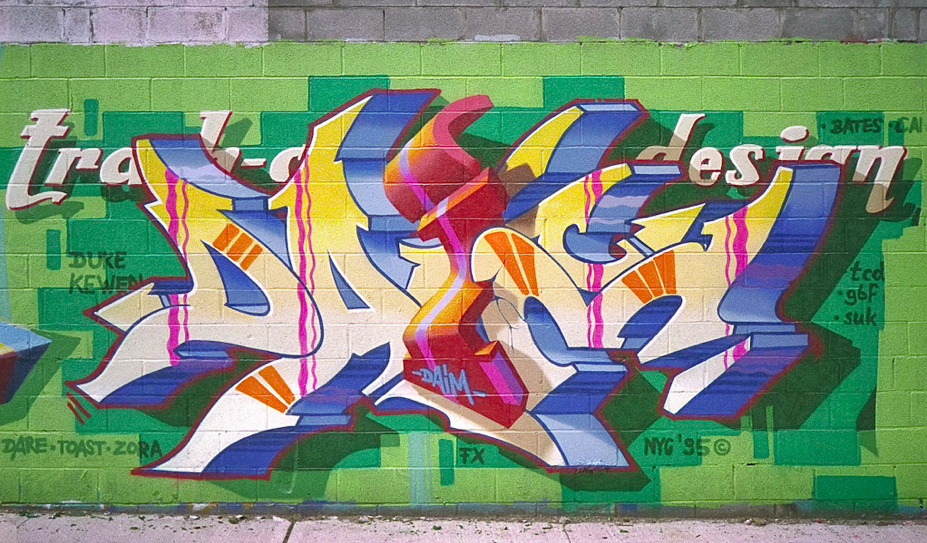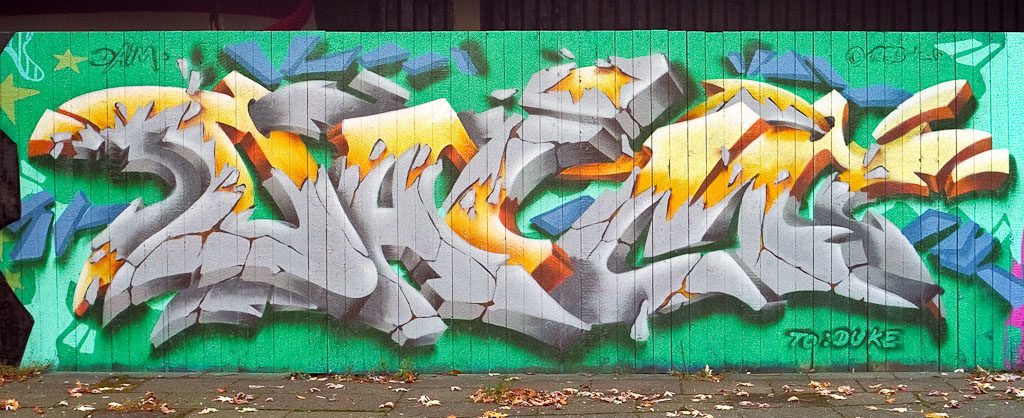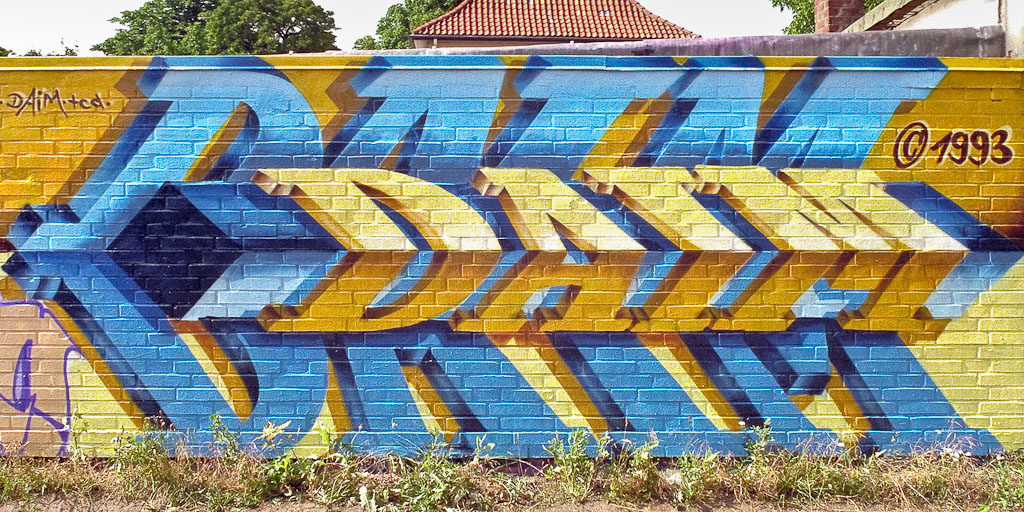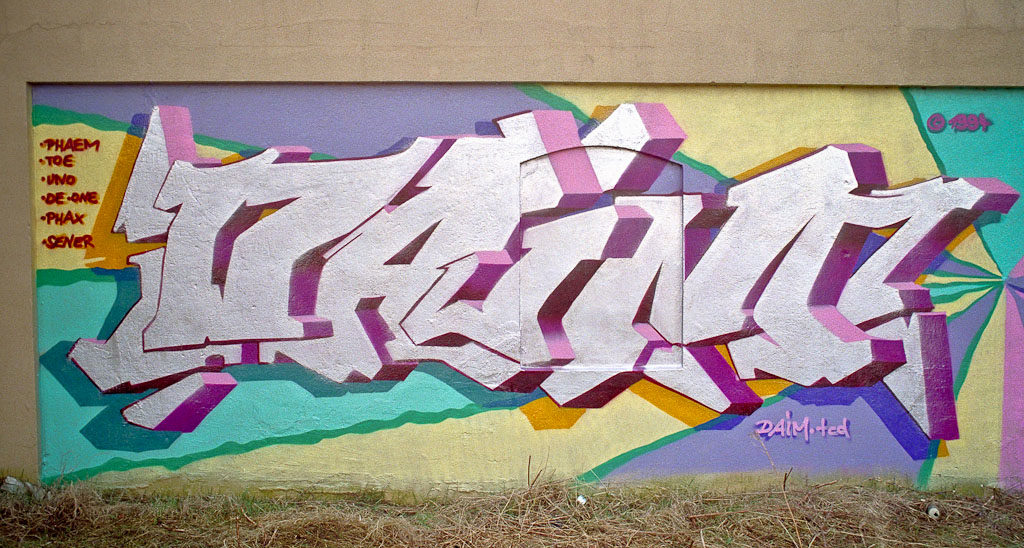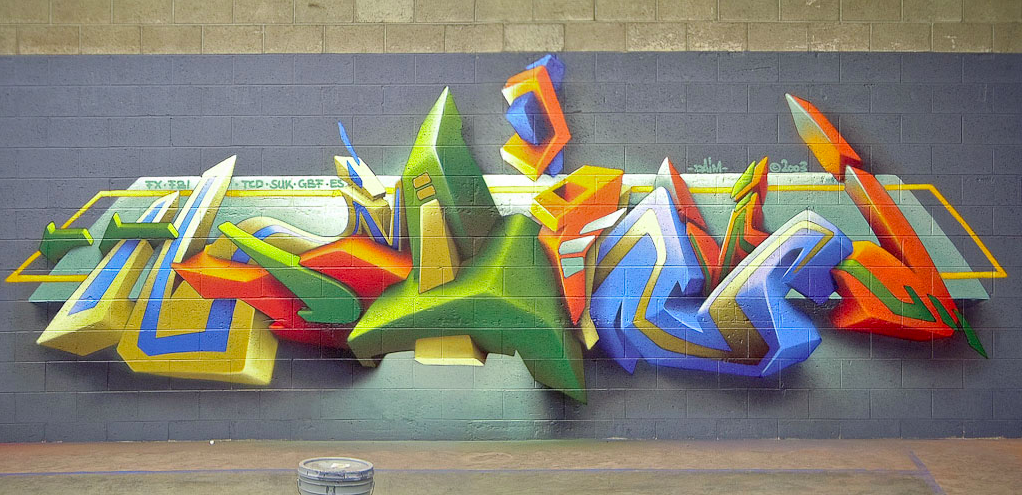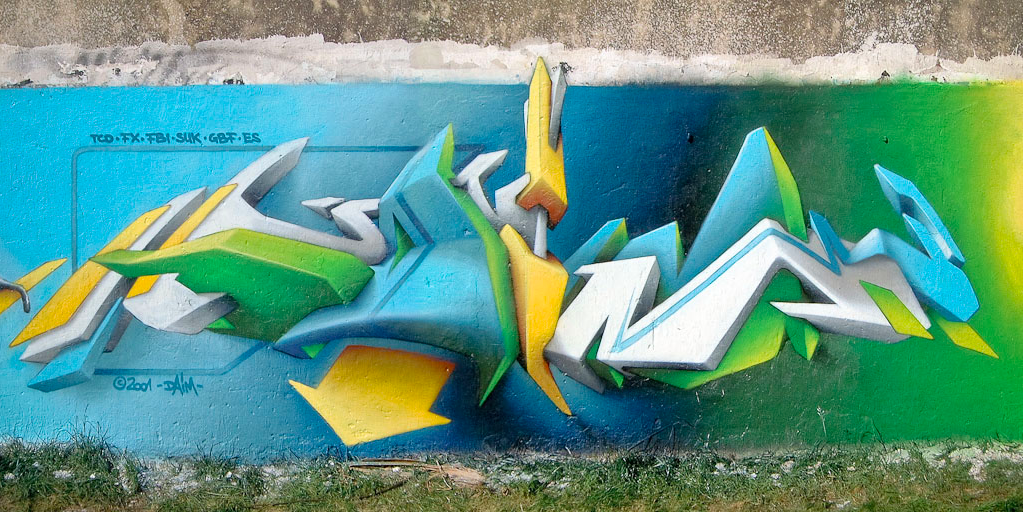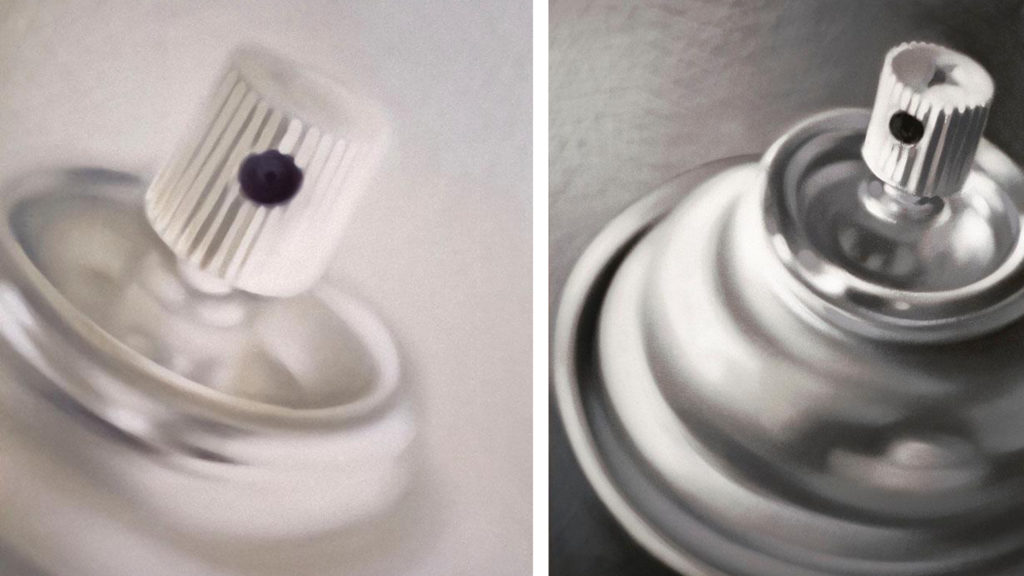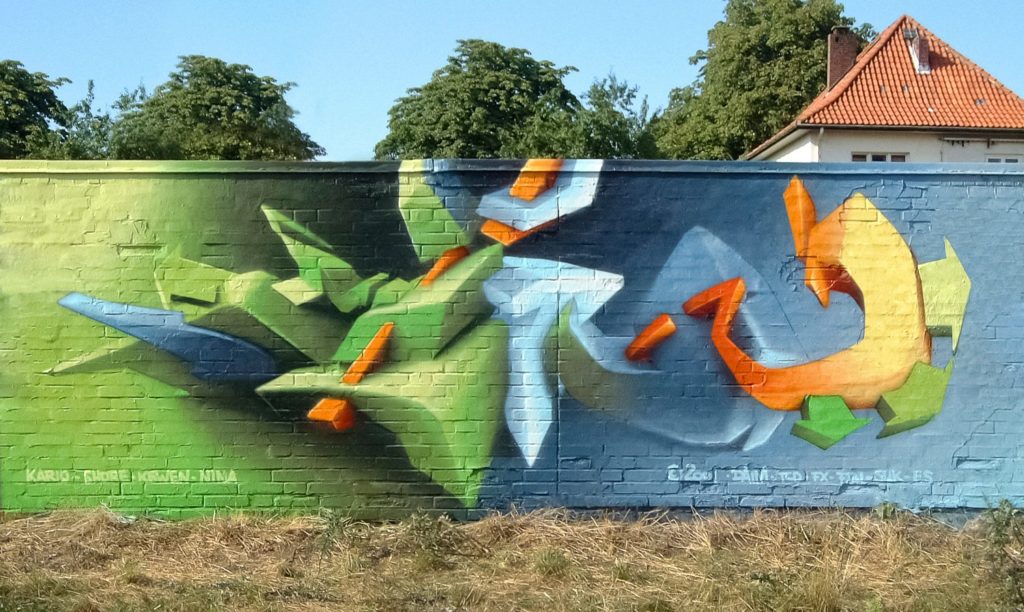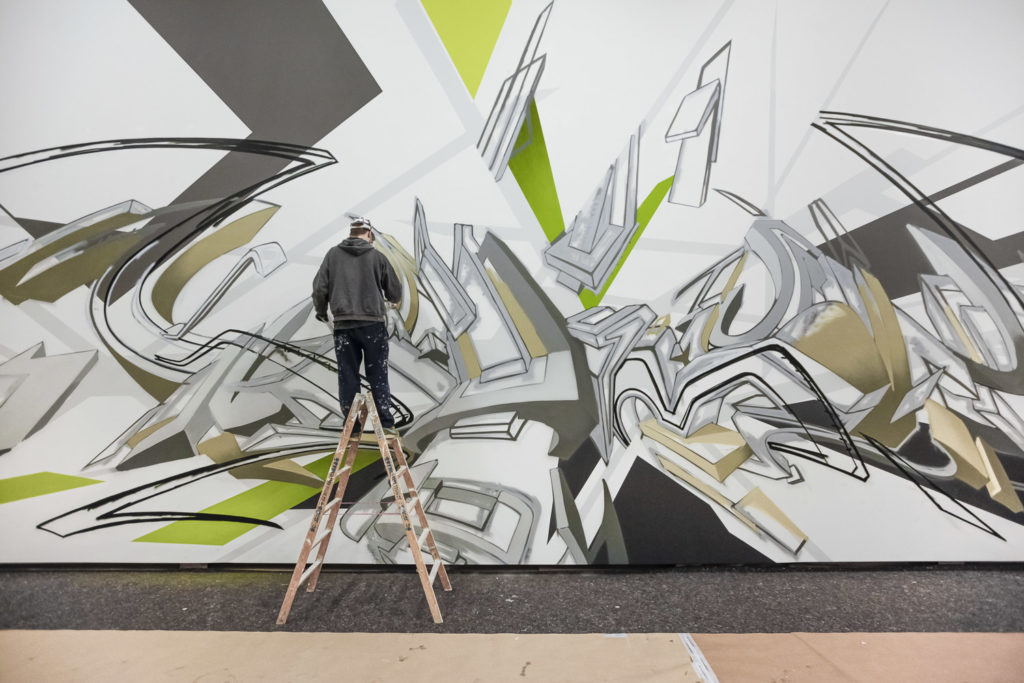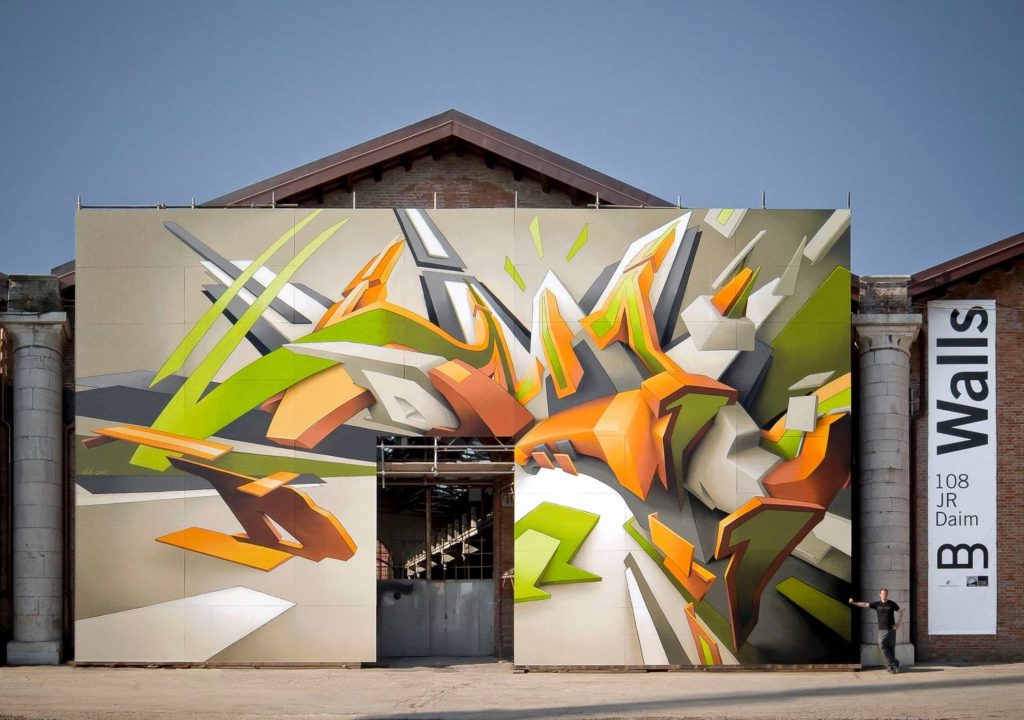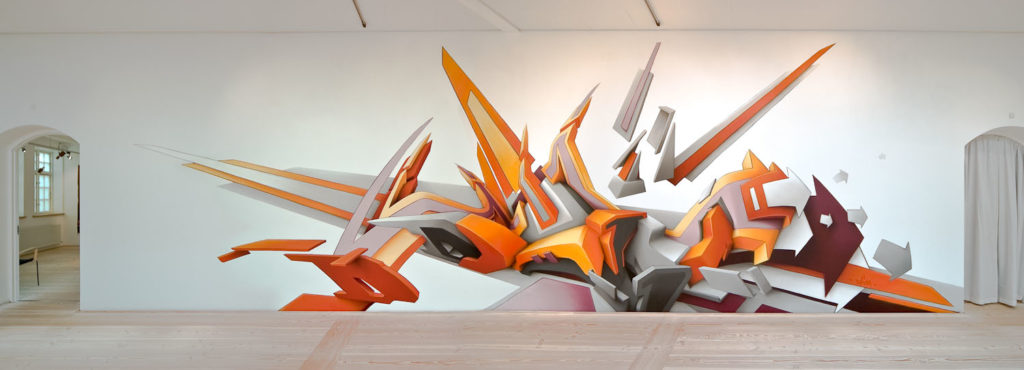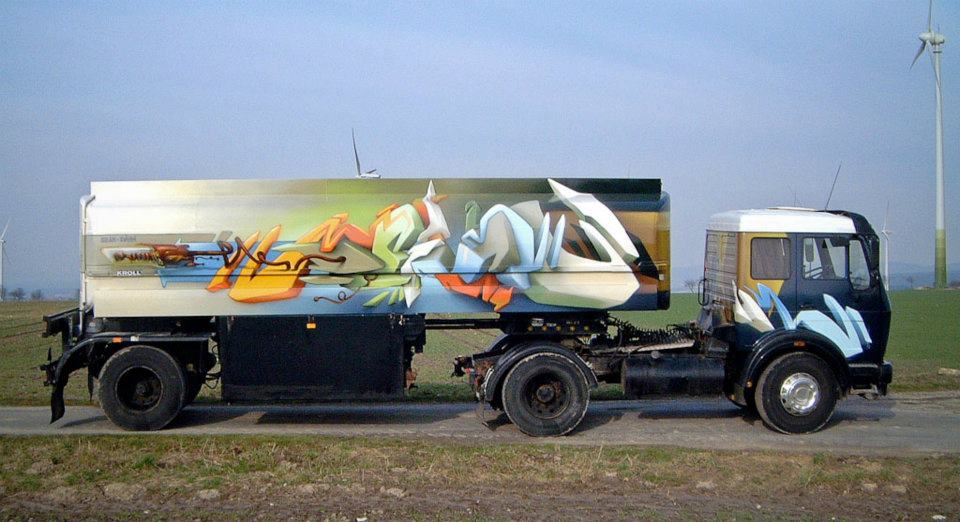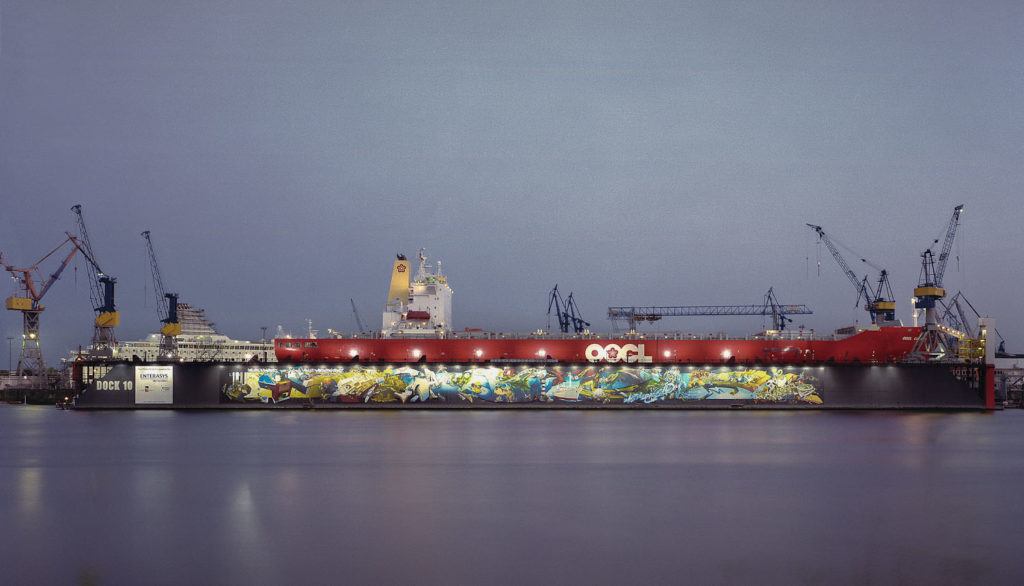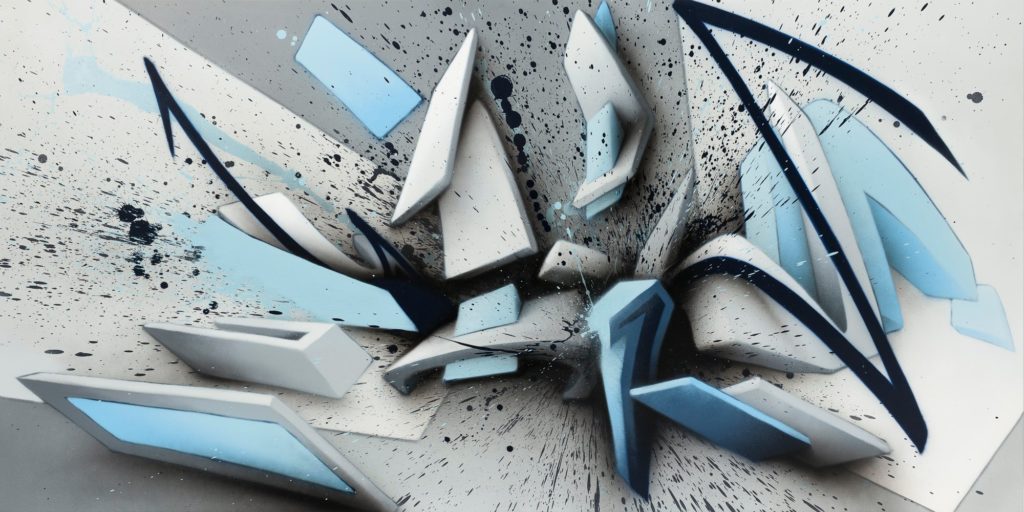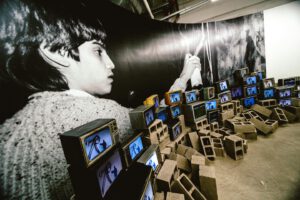บทสัมภาษณ์ที่เราจะมาพูดคุยและเจาะลึกในบางเรื่องราวจาก ‘Daim’ กราฟฟิตี้อาร์ทติสต์สัญชาติเยอรมันระดับตำนาน ที่ยังคงสร้างผลงานให้พวกเราได้เห็นอยู่อย่างสม่ำเสมอตลอดช่วงเวลาหลายปี
คุณเริ่มสนใจการวาดรูปตั้งแต่เมื่อไหร่และเพราะอะไร ?
ผมเริ่มต้นด้วยการเขียนกราฟฟิตี้ตั้งแต่ปี 1989 ตอนนั้นผมอายุ 17 ปี ซึ่งช่วงเวลานั้นผมก็เริ่มที่จะตามเก็บข้อมูลต่างๆ เกี่ยวกับงานประเภทนี้มากขึ้นที่เมืองฮัมบูร์กและถ่ายภาพบนกำแพงเก็บเอาไว้ จากช่วงเวลานั้นผมก็เริ่มลงมือวาดสเก็ตซ์ต่างๆ บ้างก็วาดลงแผ่นสเก็ตบอร์ด จนมีอยู่ครั้งนึง ช่วงประมาณบ่ายๆ ผมนั่งอยู่ในห้องกับเพื่อนอีกสองคน แล้วเราก็คุยกันว่าจะออกไปพ่นข้างนอกกัน แล้วพวกเราก็เริ่มพ่นบนหม้อแปลงเล็ก ๆ ซึ่งมันก็เป็นอะไรที่สนุกและตื่นเต้นมากๆ จากช่วงเวลานั้นผมก็เริ่มรู้ว่า การพ่นสีบนกำแพงคือสิ่งที่อยากทำและอยากค้นหาเรื่องราวของพวกมันมากยิ่งขึ้น
คุณมีเรื่องราวและเหตุผลอะไรที่ทำให้คุณสนใจงานกราฟฟิตี้ในแบบ 3D ?
ผมได้รู้จักและรับอิทธิพลมาจากหนังสือกราฟฟิตี้ของอเมริกาอย่าง ‘Spraycan Art’ และ ‘Subway Art’ รวมทั้งหนังสือกราฟฟิตี้จากเยอรมันซึ่งมีอยู่ไม่มากในยุคนั้น มันเลยเป็นเหตุที่ทำให้บรรดาศิลปินในแถบยุโรปและโดยเฉพาะเยอรมัน ชอบงานสไตล์ของผม เพราะมันแทบจะไม่มีใครทำมาก่อนเลยด้วยซ้ำ แล้วผมก็ชอบลักษณะงานของมันด้วย นอกจากนี้ผมก็เคยวาดภาพที่เหมือนจริงมาก่อนด้วยเช่นกัน โดยเริ่มวาดภาพในสไตล์แบบ Van Gogh และ Dalí ซึ่งศิลปินเหล่านี้คือแรงบันดาลใจ ที่พวกเขาทิ้งสิ่งที่งดงามเอาไว้ให้พวกเราได้ศึกษากัน ดังนั้นผมกับ Hesh คู่หูของผม พวกเราก็เริ่มทำงานที่ลงรายละเอียดในเรื่องของแสงเงามากขึ้น ฝึกฝนอยู่อย่างตลอด แต่ทั้งหมดนี้ก็ไม่ใช่เทคนิคเพียงอย่างเดียวทั้งหมดของผม ก็ยังมีงานในแบบต่างๆ ที่ผมสนใจและทำด้วยเช่นกัน
งานกราฟฟิตี้ที่คุณทำ ส่วนใหญ่แล้วจุดประสงค์หรือความต้องการของคุณจริงๆ ที่อยากสื่อสารออกไปมันคือเรื่องอะไร พร้อมด้วยมุมมองกราฟฟิตี้สำหรับคุณยังเหมือนเดิมหรือเปลี่ยนแปลงอะไรไปบ้างมั้ย ?
ในงานของผม แม้ว่ามันจะผ่านไปนานกว่า 27 ปีแล้ว ผมก็ยังคงตั้งใจที่จะเขียนชื่อว่า ‘DAIM’ อยู่อย่างตลอด แล้วผมก็คิดว่ามันก็คงจะเป็นคำแรกและคำสุดท้ายที่ผมจะเขียนออกมา แล้วมันก็เป็นแรงจูงใจของผมด้วยที่จะแสดงออกสิ่งเหล่านี้ออกมา อย่างไรก็ตามงานของผมส่วนใหญ่มันก็จะเกี่ยวกับการสร้างและการถอดแบบของตัวอักษรด้วยไอเดียเฉพาะตัวของผม แต่ในขณะเดียวกัน ผมก็ตั้งคำถามเกี่ยวกับงานตัวเองเช่นกันถึงรูปแบบต่างๆ ที่มันจะสื่อสารถึงผู้คนไปในรูปแบบไหน สำหรับผมแล้วการพัฒนาและสร้างคุณลักษณะของสไตล์นั้น มันเป็นสิ่งที่สำคัญและจำเป็นอย่างยิ่ง ซึ่งความชัดเจนนั้น มันเริ่มตั้งแต่ช่วงปี 1991 ที่ผมเริ่มเขียนชื่อว่า DAIM ครั้งแรก ซึ่งตอนนั้นสำหรับผมแล้วหลายๆ อย่างมันชัดเจนที่สุดสำหรับตัวของผม แล้วผมก็ได้รับรู้อะไรที่เกี่ยวกับตัวเองและบุคลิกภาพของผมเองมากขึ้นเช่นกัน ซึ่งมันสะท้อนตัวตนของคุณออกมา
งานของคุณส่วนใหญ่ จะเป็นการทำฟอนต์เป็นหลัก ซึ่งถ้าเอาตามหลักของคุณ งานพวกนี้มันหาแรงบันดาลใจหรือวิธีคิดงานจากสิ่งใด คุณมีวิธีคิดงานอย่างไร ?
อย่างที่ผมบอกไป งานของผมส่วนใหญ่มันเกี่ยวกับการสร้างและการถอดรหัสคำ แต่พร้อมกันนั้นมันก็มีการตั้งคำถามอยู่เหมือนกัน ซึ่งผมจะยกตัวอย่างให้ฟังอย่างงาน Graffiti เนี่ย มันเป็นเทคนิคที่เฉพาะตัว รวมทั้งในเรื่องของสีที่คุณไม่สามารถผสมหรือทำขึ้นมาเองได้ สำหรับผมแล้วมันเป็นอะไรที่น่าตื่นเต้นที่จะพยายามทำงานออกมาให้ดูสมบูรณ์แบบที่สุดซึ่งก็อย่างที่ผมบอกไป ผมสนใจและทำงานศิลปะในหลายๆ แบบ ซึ่งมันช่วยผมได้มาก มันทำให้ผมสามารถขยายงานของตัวเองและเอาชนะข้อจำกัดบางอย่างได้ อย่างการทำงานประติมากรรม ผมก็ต้องนึกถึงมุมมองที่เห็นจากด้านหลัง ซึ่งผมไม่เคยนึกถึงเรื่องนี้มาก่อน
ช่วงยุคแรกๆ คุณได้ออกไปทำงานในแบบ Tags / Bombing บ้างมั้ย ?
แน่นอน ! ในช่วงปลายยุค 80 ไม่มีความเป็นไปได้เลยที่การพ่นสีสเปรย์มันจะถูกกฎหมาย มันจะมีเพียงไม่กี่พื้นที่เท่านั้นที่ถูกสงวนไว้สำหรับศิลปินชื่อดังเท่านั้น แต่สุดท้ายแล้วการพ่นกราฟฟิตี้มันก็ยังผิดกฎหมายอยู่ดีแหละ แต่ถึงอย่างนั้นเราก็ยังมีช่วงเวลาในการทำงานช่วงกลางคืน ซึ่งมันเหมาะที่สุดแล้วที่จะพัฒนาสไตล์และเทคนิคของคุณได้
งานของคุณส่วนใหญ่มีอิทธิพลต่อพื้นที่อย่างไรบ้างมั้ย ?
นี่ถือว่าเป็นความเข้าใจอีกอย่างหนึ่งที่ผมเก็บรวบรวมมาตลอดจากการทำงานของผม นั่นคือการให้ความสำคัญกับการนำเสนอผลงานต่อพื้นที่สาธารณะ ซึ่งการทำงานจะเป็นสิ่งที่กำหนดพื้นที่นั้นๆ และนี่ก็คงเป็นความคิดเห็นของผม ซึ่งงานกราฟฟิตี้นั้นมันไม่สามารถเป็นงานศิลปะได้ด้วยตัวมันเอง ซึ่งถ้าคุณใช้แปรงหรือสีน้ำมัน มันก็เป็นงานศิลปะแบบหนึ่งโดยอัตโนมัติ แต่ในความคิดของผม ศิลปะมันต้องมีการกำหนดด้วยเทคนิค อย่างเมื่อปี 2005 ผมได้ร่วมมือกับองค์กรในเรื่องของการจัดนิทรรศการ ซึ่งมันก็มีในส่วนของผนังขนาดใหญ่อย่างที่ Art Cologne, Villa Merkel, Kunsthalle Barmen หรืออย่างงาน Biennale ในเมืองเวนิส ผลงานของผมมันเปลี่ยนไป ไม่เป็นในลักษณะบริบทของถนน แต่ถึงอย่างไรก็ตามผมก็ยังต้องการทำงานที่โดดเด่นในรูปแบบใหม่ๆ อยู่ตลอด
คุณเคยมาทำกราฟฟิตี้ที่เมืองไทยด้วย ช่วงนั้นคุณมาทำที่นี่ได้ยังไงแล้วกระแสในตอนนั้นกราฟฟิตี้ในเมืองไทยเป็นอย่างไรบ้าง ?
มันจะเป็นช่วงประมาณปี 2001 ผมรู้จักกับ ‘Cider’ ซึ่งผมมากรุงเทพในช่วงเวลาสั้น ๆ แล้วมันก็อยู่ในช่วง Graffiti World Tour ของผมด้วย ต่อมาผมก็เดินทางไปยังออสเตรเลีย / นิวซีแลนด์ / อเมริกาใต้และอเมริกาเหนือ พร้อมกับเพื่อนของผมอย่าง CanTwo, Codeak และ Tasek แต่มันก็น่าเสียดายเหมือนกันที่เราไม่สามารถใช้เวลาได้นานมากนักในกรุงเทพ แต่ตอนนั้นมันก็ถือว่าเป็นสิ่งที่เราได้สัมผัส ซึ่งเป็นอะไรที่น่าตื่นเต้นและน่าสนใจจริงๆ
แล้วตอนนี้คุณกำลังทำอะไรอยู่บ้างหรือมีโครงการอะไรที่น่าสนใจของคุณ ?
จากปีที่ผ่านมา ผมได้ทำโครงการต่างๆ ที่น่าตื่นเต้นมาก เช่น นิทรรศการ Cross the streets ที่ MACRO พิพิธภัณฑ์ศิลปะร่วมสมัยในกรุงโรม อิตาลี, งาน Scale Wall Art ในมิวนิค แต่ปีนี้ก็ถือว่าเป็นอะไรที่น่าตื่นเต้นและน่าติดตามเช่นกัน
คติในการทำงานศิลปะของคุณ ?
มองไปข้างหน้า แต่อย่าลืมอดีต
*English*
Could you please tell us about the beginning of your art career from the very beginning ? / How did you get started ? / Tell us a brief history about yourself ?
When I started with graffiti writing in 1989 I was already seventeen years old. I was already interested in graffiti for around a year, have been driving through the streets of Hamburg and taken pictures of walls. I then had a few spray cans that were originally meant for painting my skateboard. On this one afternoon I sat in my room with two friends, our eyes caught the cans and we ran out in broad daylight and painted a little transformer station. From that moment on I knew that I didn’t want to do anything else than painting. It was exactly what I had always been searching for. From the very beginning, I also worked on canvas. However, although I was working on canvas and also started participating in exhibitions rather swiftly, I also started writing on the streets illegally, as you had no other choice back then.
Back in the early days you started to paint, what was your style like ? / What is it about 3d graffiti that you found fascinating ?
Of course I have known the American documentations “Spraycan Art” and “Subway Art”, but my first book about Graffiti was a little German graffiti book. Because of this European and especially German writers mainly characterized my style. Also I have been drawing photo realistically long before I started painting. Van Gogh and Dalí – those artists definitely left an impression at the beginning. In their works I never saw an outline. That’s why I also did not see a sense in giving letters an outline while writing. Consequently I, together with my back then partner Hesh, started to shade – to create forms not with an outline but with the placement of light and shadow. But this technique is certainly not the only facet of my work.
Overview What is the main concept behind your work in terms of expression, message, and idea that you try to deliver to the audience and the public ? From then to now, have your perception towards graffiti changed ? / And, Why ?
In my works even after more than 27 years I still depict my writer’s name – DAIM. Although reduction is initially the last word that one would attribute to the style of my works, relating to the choice of my motive this expression is definitely appropriate. However my work is mostly about the construction and deconstruction of typography. It’s about catching this moment between erasure and remaining, it’s about constructing letters, compose form but simultaneously questioning it. And then the works of course have a very personal sphere….For me developing and enhancing my own style is very important and absolutely essential to my work! In 1991 I wrote DAIM for the first time. After all those years my use of the name DAIM is becoming more and more complex. I perceive it as a kind of self-portrait – my entire personality has impact on the works. By concentrating on a certain idea, by working on a certain piece for a long time frame, by totally engaging in this process, you get to know a lot about yourself and your personality. And this of course can be seen again in the works, that I create. It’s this constant evolvement of your work and your character that still fascinates me.
It is very unique and fascinating on how you create your letters. Please guide us through your thought and process behind your font and lettering. What is your technique and tips?
As I said, my work is mostly about the construction and deconstruction of a word. It’s about constructing letters, compose form but simultaneously questioning it. I am also interested in the limitations that Graffiti as a technique seems to have at the first sight: The colours are dictated from the industry, you can’t mix them up by yourself easily… For me it is exciting to try to work perfectly with a technique that is imperfect. In 1996, during my studies of Fine Arts, I was then able to crucially expand my work and overcome those limitations by working with or on other mediums: As a sculptor I suddenly had to think about how my lettering looks from behind. I had never thought about that before, but suddenly the beholder was able to walk around the letters and then the letters also casted natural shadows. I had been spraying those before. Later I also experimented with taping graffitis as a new technique.
In the early days, were you into tagging/bombing as well ?
Of course! At the end of the 80ies there were no possibilities to spray legally. There were only very few legal areas and they were reserved for the “Kings” in those days. Only because of illegal activities at night you could develop your style and your technique. And in that way you could start little by little to realize legal works as well.
Is your work mostly space influenced ?
This was another realization that I gleaned from my art studies: the necessity of giving attention to the presentation of the work. In the public sphere, the perception of the work is a given. But in the interior space? I didn’t merely want to hang a few canvases on the wall, but was seeking a more comprehensive form of presentation. The result was pretty clear – and this had already been my opinion – that graffiti can’t automatically be art. If you take a brush and oil paint and smear around with it a little, this is not art automatically either. In my opinion art has to be defined by something different than just by technique.From around 2005 onward, when my collaboration with Rik Reinking began, one can clearly perceive a shift in my work. There were increasingly more participations in exhibitions and they became more important. For example, the large wall pieces at the Art Cologne, the Villa Merkel, the Kunsthalle Barmen in Wuppertal, or also my contribution to the program accompanying the Biennale in Venice. My works changed in a manner that would not have been possible in the context of the street. Yet I worked almost exclusively in museums and less in gallery spaces where the sales aspect is dominant. I still perceive the museum space as a public space. And I keep trying to conquer this space with its very distinctive requirements in new ways over and over again. In that way I had enough room for thoughts and freedom to create new works.
We have heard that you have been in Thailand and worked on a project here before. How did you connect for the project? What do you think about the graffiti & street art scene in Thailand at that time ? / Whats the feedback and how do they respond to your work ?
I had a short but intensive stay with “Cider” in Bangkok in 2001 when we were on our “Graffiti-World-Tour”. Later I was continuing traveling to Australia, New Zealand as well as South- and North-America with CanTwo, Codeak and Tasek. Unfortunately we could not spend a really long time in Bangkok, but what we experienced was really exciting and interesting.
What are you doing now or are there any interesting projects ?
I have done very exciting projects in 2017 like the exhibition “Cross the streets” at MACRO – Museum of Contemporary Art in Rome, Italy, SCALE WALL ART in Munich or the NIKE WHQ Campus Expansion Art Project in the US. But an exciting year of 2018 lies ahead.
What is your favorite quote ?
Look ahead but don´t forget the past…
…………………………..
Follow Artist : Daim
Credit Foto : Daim
Thank You For Interview : Daim
…………………………..

